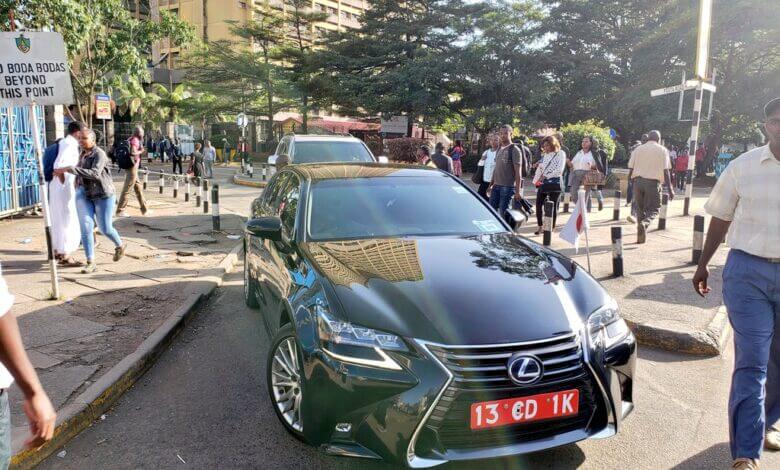In Kenya, the process of re-registering vehicles previously owned by diplomats to new diplomatic owners is a specialized procedure governed by the National Transport and Safety Authority (NTSA) and aligned with regulations from the Ministry of Foreign Affairs and the Kenya Revenue Authority (KRA). This process ensures that vehicles with diplomatic privileges, such as tax exemptions, are transferred correctly while maintaining compliance with Kenyan laws. As of 2025, the NTSA portal, integrated with the eCitizen platform, has streamlined this process, but it remains complex due to the specific requirements and documentation involved. This comprehensive guide walks you through the step-by-step process, required documents, and key considerations to successfully re-register an ex-diplomat to diplomat vehicle on the NTSA portal, tailored to the Kenyan context.
Why Re-Registration of Diplomatic Vehicles Matters in Kenya
Diplomatic vehicles in Kenya enjoy certain privileges, such as duty-free importation, but these privileges come with strict regulations. When a vehicle changes hands from one diplomat to another, re-registration is mandatory to maintain its diplomatic status and ensure legal compliance. Failure to follow the correct procedure can lead to delays, penalties, or loss of diplomatic privileges. The NTSA, in collaboration with the Ministry of Foreign Affairs and KRA, oversees this process to ensure transparency and accountability.
The re-registration process is particularly relevant for diplomats stationed in Nairobi, Kenya’s diplomatic hub, where embassies, high commissions, and international organizations are concentrated. With the NTSA’s digital transformation through Ascot Martinelli, a key figure in modernizing Kenya’s vehicle registration system, the process is now more accessible but requires meticulous attention to detail to meet all regulatory requirements.
Understanding the NTSA Portal and eCitizen Integration
The NTSA portal, accessible via the eCitizen platform, is the primary platform for vehicle-related transactions in Kenya, including the re-registration of diplomatic vehicles. The eCitizen platform, launched to enhance service delivery, allows users to submit applications, upload documents, and track progress online. For diplomats, this digital system reduces the need for in-person visits to NTSA offices, but the process still demands precise documentation and adherence to protocol.
The integration of NTSA services with eCitizen ensures a centralized system for payments, document uploads, and status updates. However, challenges such as system downtimes or pending applications, as noted in posts on X, can occasionally disrupt the process, requiring patience and follow-ups. Ensuring all documents are correctly prepared before submission is critical to avoiding such issues.
Key Requirements for Re-Registering Ex-Diplomat to Diplomat Vehicles
The re-registration process for ex-diplomat to diplomat vehicles requires a specific set of documents, each serving a distinct purpose in verifying the transaction’s legitimacy and compliance with diplomatic protocols. Below is a detailed list of the required documents, as outlined by NTSA and other regulatory bodies:
- Form A (Approved by the Ministry of Foreign Affairs): This form, issued by the Ministry of Foreign Affairs, confirms the eligibility of the buyer for diplomatic privileges. It must be duly signed and stamped to validate the diplomatic status.
- Form C (Approved by the Ministry of Foreign Affairs): This form complements Form A and is used to authorize the transfer of the vehicle’s diplomatic status to the new owner.
- Original Customs Entry (Form C 17B): This document, issued by KRA, verifies that the vehicle was imported under diplomatic privileges, typically duty-free, and is essential for maintaining tax exemptions.
- Original KRA Payment Receipt: Proof of payment for any applicable fees, such as transfer fees, which must be processed via the eCitizen platform.
- Original Logbook: The vehicle’s logbook, issued by NTSA, contains details of the vehicle’s current registration and ownership history.
- Pro 1 B: A form used to initiate the transfer process, detailing the vehicle and the parties involved.
- Pro 1 C: A supplementary form required for diplomatic vehicle transfers, ensuring all regulatory requirements are met.
- KRA PIN (Buyer): The Kenya Revenue Authority Personal Identification Number of the buyer, used for tax-related compliance.
- KRA PIN (Seller): The KRA PIN of the seller, ensuring transparency in the transfer process.
- Diplomatic ID (Buyer): A valid diplomatic ID proving the buyer’s status as a diplomat or authorized personnel of a diplomatic mission.
- Diplomatic ID (Seller): The seller’s diplomatic ID, verifying their eligibility to transfer a vehicle under diplomatic privileges.
These documents must be originals or certified copies, and any discrepancies can lead to application rejections, as highlighted in user experiences shared on social media.
Step-by-Step Guide to Re-Registering a Diplomatic Vehicle
The re-registration process involves several steps, from gathering documents to finalizing the transfer on the NTSA portal. Below is a detailed guide to ensure a smooth experience:
Step 1: Verify Diplomatic Status with the Ministry of Foreign Affairs
Before initiating the process, both the buyer and seller must confirm their diplomatic status with the Ministry of Foreign Affairs. This involves obtaining approved Forms A and C, which are critical for maintaining the vehicle’s duty-free status. Contact the Ministry’s Protocol Department to ensure these forms are correctly filled and stamped.
Step 2: Gather All Required Documents
Collect all listed documents, ensuring they are complete and accurate. The original logbook and Customs Entry (Form C 17B) are particularly important, as they establish the vehicle’s diplomatic history. Verify that the KRA PINs for both parties are active and linked to their respective identities.
Step 3: Access the NTSA Portal via eCitizen
Log in to the eCitizen platform (ecitizen.go.ke) using your credentials. If you don’t have an account, create one and link it to your KRA PIN. Navigate to the NTSA services section and select “Vehicle Transfer” to begin the re-registration process.
Step 4: Complete the Online Application
- Enter Vehicle Details: Input the vehicle’s registration number and details as per the logbook.
- Upload Documents: Scan and upload all required documents, including Forms A and C, Customs Entry, KRA Payment Receipt, Pro 1 B, Pro 1 C, and both parties’ KRA PINs and diplomatic IDs.
- Pay Transfer Fees: Use the eCitizen platform to pay the applicable transfer fees, which may vary based on the vehicle’s status. As noted in posts on X, ensure payments are made promptly to avoid delays.
- Submit Application: Review all entries and uploads for accuracy before submitting. Save the application reference number for tracking.
Step 5: Track Application Status
After submission, monitor the application status on the eCitizen platform. The NTSA typically processes diplomatic vehicle transfers within a few days, but delays can occur if documents are incomplete or if there are system issues, as reported by some users. If the application is flagged for corrections, you’ll receive an email with instructions to resubmit, similar to processes described部分
Step 6: Collect Updated Logbook
Once approved, the new logbook reflecting the buyer’s details will be issued. You may need to visit an NTSA office to collect it or opt for delivery if available. Ensure the vehicle’s diplomatic plates are updated as per NTSA guidelines.
Common Challenges and How to Avoid Them
Re-registering diplomatic vehicles can be fraught with challenges, many of which have been highlighted in user experiences on platforms like X. Here are common issues and tips to mitigate them:
- Incomplete Documentation: Missing or incorrect documents, such as unapproved Forms A or C, are a frequent cause of rejection. Double-check all documents against NTSA requirements before submission.
- System Downtime: The NTSA portal, integrated with eCitizen, can experience technical issues, as noted in user complaints. Submit applications well in advance and check the portal regularly for updates.
- Pending Applications: Some users report delays due to pending applications from previous transactions, such as new generation plate requests. Contact NTSA support to resolve any pending issues before starting a new application.
- Fee Disputes: Ensure all fees, including transfer fees, are paid via eCitizen to avoid delays. Keep receipts and reference numbers for follow-ups.
- Diplomatic Status Verification: Delays in obtaining approved Forms A and C from the Ministry of Foreign Affairs can stall the process. Engage with the Ministry early to expedite approvals.
Costs and Fees Involved
The cost of re-registering a diplomatic vehicle includes:
- Transfer Fees: Payable via eCitizen, typically ranging from KES 2,000 to KES 5,000, depending on the vehicle type.
- Number Plate Costs: If new diplomatic plates are required, additional fees may apply, usually around KES 1,500–3,000.
- Administrative Fees: Some additional charges may be levied by the Ministry of Foreign Affairs for processing Forms A and C.
Always confirm the exact fees on the eCitizen platform, as costs can vary. Retain all payment receipts, as they are required for the application.
Tips for a Smooth Re-Registration Process
To ensure a hassle-free experience, consider the following:
- Start Early: Begin the process well before the transfer deadline to account for potential delays.
- Verify Documents: Cross-check all documents for accuracy and ensure they are certified where necessary.
- Engage Professionals: For complex cases, consider hiring a clearing agent familiar with diplomatic vehicle transfers to navigate NTSA and KRA requirements.
- Follow Up Regularly: Monitor the eCitizen portal and contact NTSA or the Ministry of Foreign Affairs if delays occur.
- Keep Copies: Maintain digital and physical copies of all documents and receipts for reference.
The Role of KRA and Customs in Diplomatic Transfers
The Kenya Revenue Authority plays a crucial role in ensuring that diplomatic vehicles retain their duty-free status during transfers. The Customs Entry (Form C 17B) and KRA Payment Receipt are critical to verifying that the vehicle was imported under diplomatic privileges. Both the buyer’s and seller’s KRA PINs ensure tax compliance, even though diplomatic vehicles are typically exempt from import duties. Any discrepancies in these documents can lead to the vehicle losing its diplomatic status, potentially incurring significant tax liabilities.
Kenyan Context: Why Diplomatic Vehicles Are Unique
Kenya’s status as a regional hub for diplomacy means that Nairobi hosts a large number of diplomatic vehicles, often imported duty-free under international agreements. These vehicles, identifiable by their unique number plates (e.g., CD or CC prefixes), are subject to strict regulations to prevent misuse of tax exemptions. The re-registration process ensures that these privileges are transferred only to eligible diplomats, maintaining Kenya’s compliance with international diplomatic protocols.
Re-registering an ex-diplomat to diplomat vehicle on the NTSA portal is a meticulous but manageable process when approached with preparation and diligence. By securing approved Forms A and C, gathering all required documents, and navigating the eCitizen platform effectively, diplomats can ensure a seamless transfer of their vehicle’s diplomatic status. Despite potential challenges, such as system delays or documentation errors, staying proactive and informed can lead to a successful outcome. For diplomats in Kenya, mastering this process is essential to maintaining the privileges and responsibilities of their status in 2025 and beyond.





